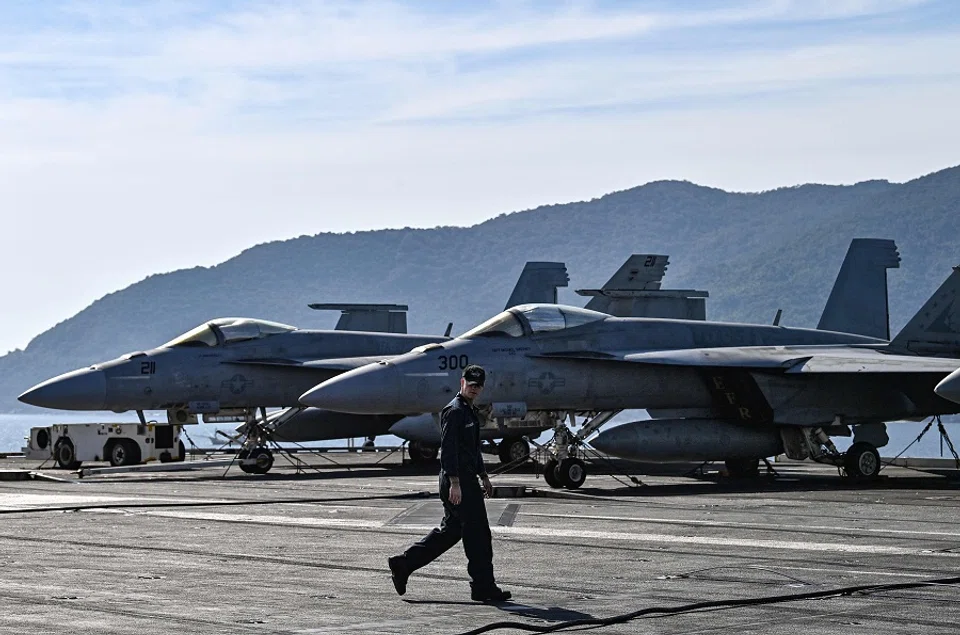Looking in the wrong direction: US Navy's superior strike capability does not ensure victory
Although the US Navy's aircraft carrier fleet dwarfs that of China in quantity, quality and combat experience, the closer the US fleet gets to the Chinese coast the more vulnerable it becomes.

In an interview with CBS News in July, Admiral Samuel Paparo, commander of the US Navy Pacific fleet, said that the US was ready and capable of defeating China. He emphasised the US Navy's superiority in firepower and the number of aircraft carriers. However, things are a bit more complicated.
In his interview, Paparo proudly described the tremendous firepower of an American aircraft carrier strike group. According to the admiral, a US aircraft carrier was capable of launching 150 daily sorties and delivering 900 precision-guided munitions (PGMs). The US currently operates 11 nuclear-powered aircraft carriers. Therefore, in theory, the US could launch around 1,650 daily sorties and deliver close to 10,000 PGMs. No doubt an impressive display of firepower and American technological prowess.
There is no doubt that the US Navy has a much greater striking capability.
The US Navy's aircraft carrier fleet dwarfs that of China in quantity, quality and combat experience. China currently operates two conventionally powered aircraft carriers, the Liaoning and the Shandong. These vessels are upgraded versions of the 1970s Soviet models and are no match for US carriers. China's third and most modern aircraft carrier is the Fujian, which is currently undergoing "sea trials". However, the Fujian is conventionally powered and smaller than US aircraft carriers.

In April, the Chinese Navy (PLAN) aircraft carrier Liaoning beat its record by launching 320 aircraft sorties in 15 days. In late July, the PLAN's second aircraft carrier the Shandong made a new record by launching 620 aircraft sorties during the 18-day exercise. The maximum range of operations achieved so far by a Chinese aircraft carrier group was 700 kilometres away from the Chinese coast. There is no doubt that the US Navy has a much greater striking capability.
Preparing for the wrong type of war
The number of aircraft carriers and sorties that it can launch are relevant factors in an open naval battle on the high seas. The US Navy, it seems, expects the PLAN to engage in an open sea battle midway between the two nations. However, China has no plans to fight the US in a classic conventional naval battle. The Chinese armed forces is well aware of its weaknesses and will not play to America's strengths.
China has in the past two decades been perfecting the art of asymmetric warfare to counter US technological superiority. It has deployed thousands of highly advanced missiles with an increasing range and lethality. The PLA has deployed these missiles off the coast of Taiwan and in at least three artificial islands it built in the South China Sea. This means that China can now target US aircraft carriers and naval facilities as far away as Guam, 4,700 kilometres away from the Chinese coast. US aircraft carrier strike groups will have to get within at least 2,000 kilometres of the Chinese coast to launch their aircraft.
The closer the US fleet gets to the Chinese coast the more vulnerable it becomes.

The closer the US fleet gets to the Chinese coast the more vulnerable it becomes. US aircraft carrier strike groups rely on the Aegis defence system carried by two to four escort destroyers. As early as 2004, a US Navy captain told me in Honolulu, "The Chinese are deploying hundreds of cruise and ballistic missiles near Taiwan. Imagine dozens of missiles being fired at one of our carriers. It will overwhelm our Aeges system and all it takes is one or two hits to sink an aircraft carrier."
Two decades later, there are thousands, not hundreds, of missiles waiting for the US Navy, including new deadly systems such as hypersonic missiles and hypersonic attack drones. At present, there is no reliable defence against hypersonic weapons and China is believed to be ahead of the US in this field.
Within 2,000 kilometres of the Chinese coast, the PLA will not only have the advantage of being under its protective missile umbrella, but will also operate under its air defence cover. China has one of the most advanced and concentrated air defence systems in the world. In addition, the US Navy will have to deal with China's large submarine fleet.
Rather than focus on counting the number of aircraft carriers and sorties, the US should focus on countering China's asymmetric strategy.
Theory vs practice
Under such difficult operational conditions, it is very unlikely that the US Navy would be able to launch its usual number of sorties and munitions, therefore significantly reducing its firepower advantage. Rather than focus on counting the number of aircraft carriers and sorties, the US should focus on countering China's asymmetric strategy. Upgrades to Guam's defences and other facilities are more important than counting sorties and payloads. The US and its allies should invest more in missiles, drones and hypersonic technology.

Admiral Paparo was a former aircraft carrier pilot and a very good one at that - he is a graduate of Top Gun, the elite of American fighter pilots. However, the Chinese have no plans to meet the admiral on his terms.
Related: An uptick in US-China relations? Not so fast | With the Fujian, is China catching up to the US in aircraft carrier manufacturing technology? | China's third aircraft carrier: No need to panic just yet | What does the high-profile launch of three new PLA warships tell us? | China displays its new weapons amid cross-strait tension | China's expanding its naval power, and it's not afraid to show it



![[Photos] Fact versus fiction: The portrayal of WWII anti-Japanese martyrs in Taiwan](https://cassette.sphdigital.com.sg/image/thinkchina/3494f8bd481870f7c65b881fd21a3fd733f573f23232376e39c532a2c7593cbc)

